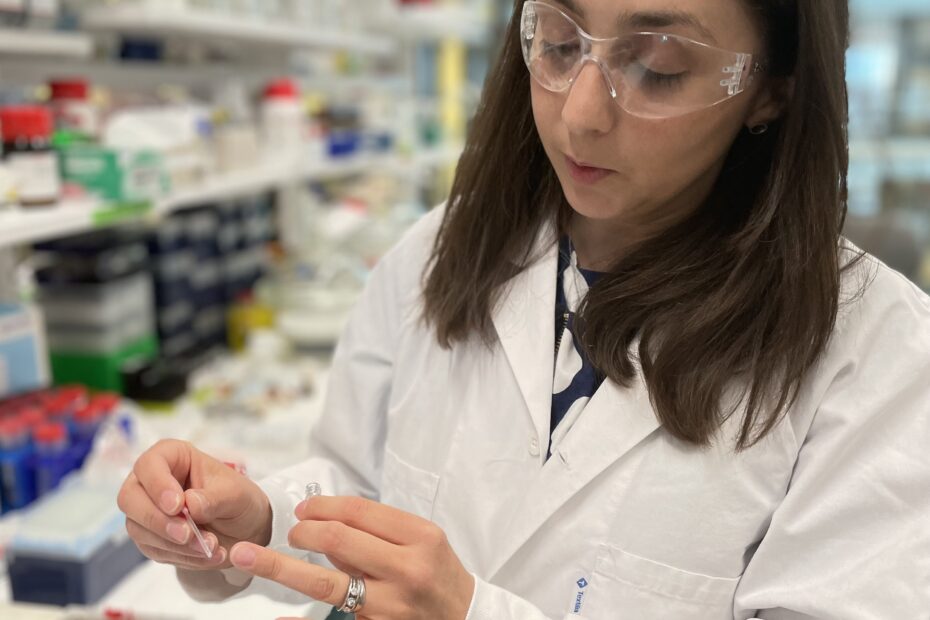Hanna Barriga has over 10 years of experience engineering and characterizing lipid systems. Her research focuses on understanding how lipid structures impact nanoparticle performance, which includes developing lipid nanoparticles for RNA delivery. She started her science career studying physics and later earned her Ph.D. in lipid biophysics from Imperial College London. Since moving to Karolinska, she has been translating her fundamental research to study pharmaceuticals and tune the physical properties of lipid nanocarriers for drug delivery. We got the opportunity to talk to Hanna to learn how she uses research infrastructure to take her research towards the applied biology of drug targeting.
“My research focus has shifted from studying fundamental properties of lipid systems to using them to design tomorrow´s medicines”, says Hanna Barriga, researcher at the Karolinska Institutet
Hanna has been a researcher at Karolinska Institutet since 2016, when she came on a Marie Skłodowska-Curie Individual Research-fellowship to Professor Molly Stevens’ (KI) group. The team has a sister group at Imperial College in London and has used research infrastructures in the UK as well as in Sweden to shed light on the structure of lipid nanoparticles; lipid-based particles with an average diameter between 50 and 200 nanometers.
“We have studied how the composition of lipid nanoparticles influences their structure and function using neutron scattering and X-rays in the UK. In the future, we are hoping to be able to perform these experiments in Sweden at ESS and MAX IV. In addition, we have used the Cryo-EM Swedish Infrastructure Unit at SciLifeLab”, she says.
Lipid nanoparticles hold huge potential to be used in pharmaceutical applications, as vehicles to transport and deliver a payload, such as RNA, to a particular place in the body. They are already a key component in the RNA vaccines for Covid-19. To ensure efficient and effective delivery, it is crucial to find out how the structure of the nanoparticles impacts their function.
“In breast cancer, a lipid modifying enzyme (phospholipase D) is over expressed. To understand how lipid nanoparticles could be become a treatment option for breast cancer, we have studied the interaction between phospholipase D and lipid nanoparticles. We wanted to understand how the structure of the nanoparticle changed during this interaction and combined several techniques to couple our structural measurements with the nanoparticle lipid composition using a fluorescence assay and SPARTAâ (single-particle automated Raman trapping analysis) which allowed us to study the composition of individual lipid nanoparticles”, she explains.
The results show that the enzyme reacts very differently depending on the structure of the nanoparticle. For instance, nanoparticles with a structured lipid core had a ten times faster interaction time compared to particles with an aqueous core. This knowledge is fundamental for pharmaceutical purposes and could be used to design a system with well-controlled drug release – an important factor in drug delivery.
The nanoparticle structure was studied using a range of technologies. “We combined technologies; using x-rays to determine the complex nanoscale structure of the lipid mixtures, neutrons to study the particle structure, and the cryo electron microscopy (cryo EM) to validate the observations that we made. X-rays and neutrons are complementary, but you can access different information with the two technologies. With cryo EM, it is currently harder to be as quantitative for nanoparticle characterisation, but it enabled us to validate our observations”, Hanna says.
Research and scientific know-how are key for the life science community to contribute to meeting the global challenges. In the Swedish Life Science strategy, national research infrastructures are highlighted as a prioritized area, with the aim to broaden the user base and stimulate cross-sectoral collaboration, to address some of today’s grand challenges. Therefore, improved access to research infrastructures is necessary.

“Our long-term goal is to be able to control drug delivery and designate where in the body a payload is delivered. The next step in our phospholipase project will be to evaluate if we can use these enzyme responsive lipid nanoparticles for delivery”
“There are some grants available for infrastructure use, and if you are awarded time at a facility, many will contribute to travel and accommodation costs. One of the best ways to lower the threshold to accessing research infrastructure is to create a community. This enables new users to discuss and collaborate with experienced users and to connect with scientists at the research infrastructures to discuss how the different technologies can be used to answer your research questions”, Hanna explains.
Meeting Hanna Barriga we realize that she is passionate not only about conducting research but also about communicating research. Her calendar is fully booked with courses, meetings, and lessons to transfer the knowledge to colleagues also outside of her specific field.
In early September this year, she will contribute as a keynote speaker at the InfraLife integrative structural biology course which is open to scientists from academia, health care, and industry.
Moving from the office to the laboratory in Biomedicum, Barriga takes her lab coat off the hanger, grabs a pipette, shows the samples on the lab bench, and finishes:
“Our long-term goal is to be able to control drug delivery and designate where in the body a payload is delivered. The next step in our phospholipase project will be to evaluate if we can use these enzyme responsive lipid nanoparticles for delivery.”
For further information about the project contact:
Hanna Barriga, Research Specialist, Division of Biomaterials, Department of Medical Biochemistry and Biophysics, Karolinska Institute. e-mail: hanna.barriga@ki.se
Research infrastructure:
Hanna has used different research infrastructures, both nationally and internationally to answer her scientific questions. She is also currently working with the research infrastructure board at KI to create a community of researchers using or interested in using scattering techniques for their research. We have outlined the key techniques used for this study.
Cryo-EM
The Cryo-EM Swedish Infrastructure Unit at SciLifeLab offers access to state-of-the-art equipment and expertise in single particle cryo-EM and cryo-tomography (cryo-ET). The unit provides service and user training for all aspects of cryo-EM projects, including project planning, sample preparation, screening, data collection and data analysis. Additional offer ofa biweekly Drop-In Service to help researchers with data processing and/or to discuss to-be EM projects.
X-ray experiments
X-ray experiments were performed on the I22 beamline at Diamond Light Source, UK.
This autumn we will also be performing experiments on the CoSAXS beamline at MAX IV.
The CoSAXS beamline at MAX IV is a state-of-the-art multipurpose Small Angle X-ray Scattering (SAXS) instrument with opportunities to use the inherent high coherent properties of the 3 GeV MAX IV ring through X-ray Photon Correlation Spectroscopy (XPCS) experiments.
Neutron studies
Neutron experiments were performed on the Sans2d beamline at the STFC Rutherford Appleton Laboratory (ISIS Neutron and Muon Source) in collaboration with Dr. James Doutch.
In the future, neutron studies like this can be performed at the European Spallation Source (ESS) in Lund, Sweden. One in operation, in 2027, ESS will be the most powerful neutron source in the world offering great possibilities to researchers.
Related research articles:
Advanced Materials 2022, 2200839
Single Particle Automated Raman Trapping Analysis
Nature Communications, 2018, 9 (4256)
